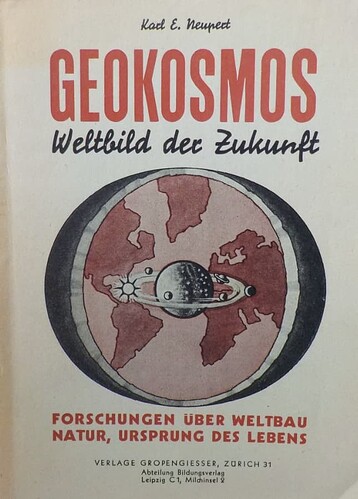Geokosmos by Karl Neupert (1942)
Translated by @john_shillsburg
Download the Book
geokosmos_2 english translation pdf john shillsburg.pdf (1.5 MB)
Overview
Geokosmos by Karl Neupert is a seminal text that explores an alternative cosmological model, challenging conventional heliocentric and convex Earth paradigms. Published in 1942, this work introduces the concept of a geocosmos, where Earth and its celestial phenomena are framed within a concave structure. Neupert’s thesis integrates observations, philosophical reflections, and scientific principles, aiming to establish a coherent theory of the universe that positions Earth and humanity in a fundamentally different spatial relationship with the cosmos.
The book appeals to those who seek to question mainstream scientific assumptions, offering an exploration of ideas that blend empirical data with metaphysical implications. Its insights are supported by meticulous diagrams, detailed arguments, and historical references, making it a cornerstone for researchers interested in concave Earth theories.
Structure and Content
1. Introduction
Neupert opens with a critique of prevailing scientific models, particularly the heliocentric system. He outlines the limitations of convex Earth theories and introduces the geocosmos as a paradigm that reconciles physical observations with a coherent, enclosed cosmological framework.
2. Geometry of the Geocosmos
This section delves into the spatial geometry of the geocosmos, describing Earth as a concave sphere with humanity living on its inner surface. Key features include:
- The curving inward shell that supports land, oceans, and the atmosphere.
- Celestial bodies, such as the Sun, Moon, and stars, residing within the enclosed system, moving in predictable orbits.
- Light bending upward, creating optical illusions of convexity.
3. Refraction and Light Behavior
Neupert focuses on the behavior of light within the geocosmos, emphasizing:
- The role of refraction in creating the illusion of distance and curvature.
- How light’s upward bending supports the perception of a convex Earth.
- Experiments and observations that challenge traditional interpretations of optical phenomena.
4. Gravity in the Geocosmos
Gravity is reinterpreted as a force stemming from longitudinal pressures within the spherical geometry. Neupert proposes:
- That gravity is not a mass-attraction force but a dynamic interplay of pressure gradients.
- How this model explains phenomena like atmospheric layers and water retention without requiring external gravitational pull.
5. Celestial Dynamics
The mechanics of celestial motion are described in detail, with Neupert outlining:
- The central role of the celestial sphere, housing stars and galaxies in fixed rotational patterns.
- The Sun and Moon’s orbits as central elements driving time cycles and natural rhythms.
6. Critique of Conventional Science
Neupert scrutinizes mainstream scientific methods and paradigms, arguing that:
- Observations have been misinterpreted to fit a heliocentric model.
- Concepts like relativity and infinite space lack empirical grounding within the geocosmos framework.
7. Philosophical Reflections
The text concludes with philosophical musings on humanity’s place within the geocosmos. Neupert asserts that:
- Understanding the geocosmos restores humanity’s connection to the universe.
- This model aligns with ancient cosmologies and offers spiritual coherence.
Key Themes and Insights
- Inverted Geometry: The geocosmos redefines spatial relationships, challenging perceptions of up and down, inward and outward.
- Light and Perception: Optical phenomena are central to understanding the concave Earth, with refraction creating illusions of convexity.
- Unified Forces: Gravity and celestial motion are unified within a pressure-based, enclosed system.
- Ancient Wisdom: Neupert aligns his theory with historical cosmologies, asserting their intuitive grasp of universal truths.
- Philosophical Relevance: The geocosmos offers a framework that restores meaning to humanity’s place in the cosmos.
Chapter Summaries
Chapter 1: Rethinking the Cosmos
Neupert critiques the heliocentric and convex Earth models, highlighting their inconsistencies. He introduces the geocosmos as a revolutionary framework grounded in observation and logic. By revisiting the fundamental assumptions of modern science, he lays the foundation for a model that prioritizes coherence and empirical alignment.
Chapter 2: Geometry and Space
This chapter elaborates on the geometric principles underlying the geocosmos. Neupert explains the inversion of convexity to concavity and its implications for spatial perception. He illustrates how this transformation not only redefines physical space but also addresses discrepancies in conventional models of the universe.
Chapter 3: Optical Illusions and Light
Neupert examines the behavior of light, focusing on refraction and its role in creating the illusion of a convex Earth. He provides examples and thought experiments to support his claims, demonstrating how upward-bending light can explain phenomena such as the horizon and the apparent motion of stars.
Chapter 4: The Nature of Gravity
Gravity is redefined as a pressure-based phenomenon. Neupert explores its effects within the concave structure, offering explanations for natural phenomena like tides and atmospheric stability. He emphasizes how this interpretation resolves inconsistencies in the traditional understanding of gravitational forces.
Chapter 5: Celestial Mechanics
The motion of celestial bodies is analyzed, with Neupert describing their roles within the geocosmos. He emphasizes the coherence of this system compared to traditional models, highlighting the predictable and harmonious movements of the Sun, Moon, and stars within the enclosed sphere.
Chapter 6: Scientific Paradigms Under Scrutiny
Neupert critiques conventional science, challenging assumptions about space, relativity, and infinite universes. He advocates for a paradigm shift that prioritizes observational data and logical consistency, rejecting models that rely on abstract mathematical constructs.
Chapter 7: Philosophy and Humanity
In the final chapter, Neupert reflects on the philosophical and spiritual implications of the geocosmos. He argues that this model reconnects humanity with the universe’s inherent order and meaning, providing a sense of purpose and interconnectedness that is absent in conventional cosmological theories.
Conclusion
Geokosmos by Karl Neupert offers a bold reimagining of the universe, positioning humanity within a concave Earth. Through detailed analysis and philosophical reflection, Neupert invites readers to challenge mainstream cosmological assumptions and consider a radically different perspective. This book is essential reading for those exploring alternative models of the cosmos.
